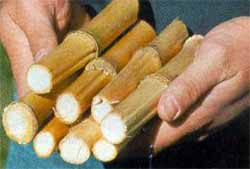A report card on corn N management
The end-of-season cornstalk test is a useful diagnostic tool that provides an overall assessment of N fertilizer practices during the current year.
With excessive early season rain and delayed planting, many corn growers are wondering if their traditional nitrogen (N) fertilizer practices were adequate this year. Growers who received unusual amounts of rain after planting or sidedress N applications are concerned about a potential late season N deficit, especially with corn being very tall and lush in vegetative growth. These growers should monitor their crops for early firing and other foliar symptoms associated with N deficiency. Even though N use efficiency can be improved by several split applications up until the tassel stage, most growers do not have the right tools to apply N beyond the typical sidedress stage in the middle of June.
 The end-of-season cornstalk nitrate test is a useful diagnostic tool to assess overall N management. The methodology and interpretation of this test were discussed in some detail in my 2011 Michigan State University Extension article, “End of season corn stalk nitrate test.” The nitrate N concentration in the lower portion of the corn stalk after the black layer formation is a good indicator of the N status the crop experienced during the season. As corn approaches maturity, plants stressed for N will remobilize N from the lower cornstalk to the kernels, resulting in a low stalk N concentration. Conversely, if plants had excess available N for maximum yield, this N tends to accumulate in the stalk.
The end-of-season cornstalk nitrate test is a useful diagnostic tool to assess overall N management. The methodology and interpretation of this test were discussed in some detail in my 2011 Michigan State University Extension article, “End of season corn stalk nitrate test.” The nitrate N concentration in the lower portion of the corn stalk after the black layer formation is a good indicator of the N status the crop experienced during the season. As corn approaches maturity, plants stressed for N will remobilize N from the lower cornstalk to the kernels, resulting in a low stalk N concentration. Conversely, if plants had excess available N for maximum yield, this N tends to accumulate in the stalk.
Accordingly, the stalk nitrate N concentrations are divided in to three broad categories:
- LOW (less than 450 ppm)
- OPTIMAL (450 to 2,000 ppm)
- EXCESS (greater than 2,000 ppm)
The LOW range indicates a N shortage situation, and often associated with visual deficiency symptoms. The OPTIMAL indicates N availability that corresponded to maximum economic returns. The EXCESS range indicates N availability greater than required for maximum economic returns. Quite often the excess range is associated with over application of N fertilizer or animal manures.
The test has a few limitations. Consideration has to be given to weather conditions that prevailed during the season. In abnormally dry years, higher nitrate levels may accumulate in the stalk and, conversely, in wet years such as 2013 the stalk nitrate levels are expected to be lower than in a normal year. Also, deficiencies of N early in the season may sometimes limit grain yield in ways that may not be directly reflected by the stalk test. Under normal conditions, however, the test values should fall within a range that will be reflective of an overall assessment of N practices during the growing season.
The test does not provide any remedy for the current year, but familiarity with the data over a number of years should assist in producers finetuning their N fertilizer practices to suit seasonal changes in weather. Please refer to MSU Extension Bulletin E2904 for the latest corn N recommendations.
Field areas with different soil types or management zones ideally should be sampled separately. The time of sampling is very critical. It is two to three weeks after physiological maturity or black layers have formed on 80 to 90 percent of the kernels. At this stage, any further mobilization of N to the kernels has ceased and most leaves have turned color.
Many Michigan soil testing laboratories will perform this test in a two- to three -ay turnaround. The MSU Soil and Plant Nutrient Laboratory charges $12 per sample.
Please refer to the End of Season Cornstalk Nitrate Test (ECNT) fact sheet for more information.
If you are interested in learning more about nutrient management, please attend the MSU Extension Soil Academy on Sept. 11, 2013. View the program brochure and register online or by mail.



 Print
Print Email
Email